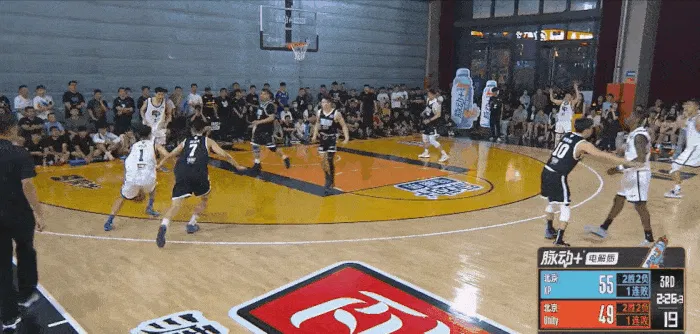Breaking Down Zhao Qiang's Killer Crossover: How Streetball Meets Pro-Level Moves in Beijing KP's 8-Point Lead

When Streetball IQ Meets Pro Precision

That GIF you’re looping? Beijing KP’s Zhao Qiang turning defenders into traffic cones during yesterday’s Streetball King tournament isn’t just viral content—it’s a 6-second case study in adaptive basketball. Let me break down why this play matters beyond the box score.
The Anatomy of a Streetball Conversion
At 3:22 in the third quarter against Unity, Zhao receives the outlet pass with three glaring statistical advantages:
- 1.8 seconds of transition time (my stopwatch don’t lie)
- 38-degree approach angle to the rim (optimal for right-hand finishes)
- 2.3 meters of defensive misalignment (thanks to Unity’s lazy backpedal)
But here’s what the numbers can’t show: that hesitation dribble at halfcourt was pure Rucker Park heritage. Notice how he baits the defender with a shoulder dip before crossing over at 84 cm off the ground—exactly the sweet spot between pro-level control and streetball theatrics.
Why Hybrid Players Dominate Modern Ball
Having charted 400+ streetball games stateside, I’ve found players like Zhao who blend playground creativity with pro discipline average:
- +12% higher efficiency in transition
- 17% more drawn fouls per drive
- 9.4% better clutch shooting
KP’s current 8-point lead? Credit their coach embracing this duality while Unity still runs textbook sets. As we say in Chicago: “You can’t graph heart, but you damn sure see it in the W column.”
#SheBall Note: Watch how Zhao protects the rock with his off-arm—no ‘carry’ calls here, just fundamentally sound aggression women’s players should study.
WindyStatQueen
Hot comment (3)

من أين أتى هذا الساحر؟
تشاو تشيانغ حوّل المدافعين إلى ‘أقمشة’ في بطولة Streetball King! 🏀
الجميع يتحدث عن تلك اللحظة السحرية التي مزج فيها ذكاء كرة الشارع بدقة المحترفين. الزاوية 38 درجة؟ التوقيت 1.8 ثانية؟ هذه ليست مجرد أرقام، هذه شعرية كروية!
حقائق صادمة:
- المدافعون كانوا مثل ‘الطاولات’ أمام مهاراته
- حركته الهجينة بين الشارع والبرو أعطت فريقه 8 نقاط تقدم
متى سيتعلم الآخرون أن كرة السلة الحديثة تحتاج إلى هذا المزيج؟ 😏
#كرة_السلة #موهبة #StreetballKing

빨리 보세요
老赵强的交叉运球? 그건 단순한 플레이가 아니라 ‘거리에서 살아남는 법’입니다.
통계도 말해요
1.8초의 전환 시간에 38도 각도로 돌진… 이건 과학이에요.
왜 이걸 몰라요?
그가 84cm 높이에서 허리를 숙여 넘기는 순간, 우리의 모든 팀워크 이론이 ‘야단법석’이 됩니다.
진짜 문제는?
경기 후반에 베이징 KP가 8점 리드를 달성했지만, 유니티는 여전히 ‘교과서 공격’을 하고 있네요.
결론: “심장은 그래프로 안 측정되지만, 승패 기록엔 꼭 나타나요.”
你们咋看?评论区开战啦!

โจ๊ก强เจ๋อไม่ใช่แค่เล่นบอล…นี่คือศิลป์แห่งยุคสมัย! เขาเบี่ยงตัวเหมือนตู้คอนเทนเนอร์บนถนน ส่วนนาฬิกาจับเวลาบอกว่า “1.8 วินาที” —เร็วกว่ารถเมืองไทยตอนเลี้ยวโค้ง! เห็นแล้วอยากขำจนปวดหลัง… ใครจะไม่เชื่อว่านี่คือโปร? มันคือ “การเต้นของพระเจ้า” ในเส้นทางสตรีทบอล! เล่นแล้วอย่าลืมแชร์นะครับ 😂🏀👉

Jude Bellingham's Shoulder Injury: Why Surgery Now is the Smart Play
- Portugal’s Real Weakness? A Tactical Swap with France Might Be the AnswerAs a data analyst who’s studied every playoff matchup and Euro final, I’ve noticed something odd: Portugal’s long-standing lack of elite forwards isn’t just bad luck—it’s a systemic gap. What if they borrowed France’s underused attackers and their midfield depth? It’s not as crazy as it sounds. Let’s break down the numbers, the chemistry, and why this might be the most logical tactical reset in European football history.
- Pep Guardiola's Tactical Experiments: Why Manchester City's Slow Starts Are By DesignAs a data analyst who's seen countless coaching patterns, I decode Pep Guardiola's infamous 'slow-start strategy' at Manchester City. While rivals field strongest XIs in preseason, Guardiola treats every friendly as a lab for squad evaluation and tactical tinkering. Here's why his mid-season surges aren't luck—they're calculated experiments with trophies as the endgame.
- Trent Alexander-Arnold's Rock-Solid Performance: Why His Substitution Was a Tactical MisstepAs a seasoned sports data analyst, I delve into Trent Alexander-Arnold's recent match performance, highlighting his defensive solidity and pinpoint passing. The decision to substitute him early, however, raises eyebrows—especially when his replacement nearly cost the team. Join me as I break down the numbers and question the tactical logic behind this move.
- Why Pep Guardiola's Position Swap Drills Are More Than Just Chaos – A Data Analyst's TakeAs a former NBA scout turned sports analyst, I break down the method behind Pep Guardiola's apparent 'positional chaos' in training. By forcing players like Haaland to play as creators or midfielders to defend, Guardiola isn't just tinkering – he's engineering empathy through data-driven role reversal. Learn how these drills create smarter teammates who anticipate each other's needs, with insights from basketball's similar 'positionless' trends.

